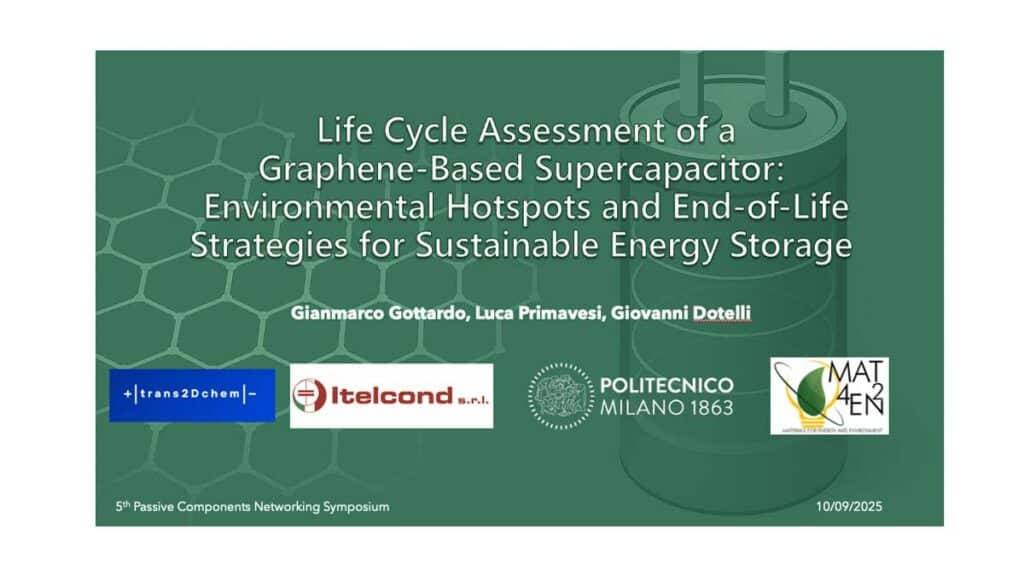The paper “Life Cycle Assessment of a Graphene-Based Supercapacitor: Environmental Hotspots and End-of-Life Strategies for Sustainable Energy Storage” was presented by Gianmarco Gottardo, Politecnico di Milano, Milan, Italy at the 5th PCNS Passive Components Networking Symposium 9-12th September 2025, Seville, Spain as paper No. 2.6.
Introduction
The global energy landscape is undergoing a critical transformation as reliance on fossil fuels proves increasingly unsustainable due to resource depletion, environmental degradation, and geopolitical pressures.
In this context, advanced energy storage solutions are essential to support renewable energy integration and achieve carbon neutrality. Supercapacitors (SCs), particularly those employing graphene-based electrodes, have emerged as promising candidates for high-power, durable, and sustainable energy storage.
However, their environmental implications across manufacturing and end-of-life management require thorough evaluation. This study presents a Life Cycle Assessment (LCA) of a Nitrogen and Fluorine doped graphene-based cylindrical supercapacitor, focusing on environmental hotspots and sustainable disposal strategies to enhance its role in future energy systems.
Key Points
- Supercapacitors deliver high power, long lifespan, and safety, but have lower energy density than batteries.
- Graphene oxide (GO) production is the most significant environmental hotspot in manufacturing.
- End-of-life recycling provides substantial environmental benefits, especially through the recovery of graphene, PTFE, and aluminum.
- Energy source for production and effective recycling strategies critically affect overall sustainability.
- A cradle-to-grave LCA approach following ISO 14040/14044 identifies clear pathways to reduce environmental impacts.
Extended Summary
The study evaluates the environmental performance of an innovative graphene-based supercapacitor using a Life Cycle Assessment that spans from raw material acquisition to end-of-life treatment. The declared unit is a single supercapacitor manufactured by Itelcond s.r.l., characterized by a 4700 F capacitance and 2.8 V rating, delivering 5.12 Wh of stored energy at a gravimetric energy density of 35.05 Wh/kg.
The methodology adheres to ISO 14040 and ISO 14044 standards and leverages SimaPro software and ecoinvent datasets for modeling. The LCA covers manufacturing (rolling, impregnation, assembly, burn-in, and palletizing), distribution, and end-of-life stages, with the use phase excluded due to the absence of a defined application scenario. Primary data from the manufacturer and background datasets from ecoinvent underpin the assessment.
Results identify the manufacturing phase—particularly the rolling stage producing the dry capacitor—as the dominant contributor to environmental impacts across most categories, including climate change, ozone depletion, and resource use. This is primarily due to the energy-intensive production of graphene oxide and the use of chemicals such as potassium permanganate and sulfuric acid. Electricity consumption, even with partial photovoltaic support, remains a key driver of emissions.
The impregnation phase is the second-largest contributor, mainly via electrolyte production impacts. Distribution impacts are negligible due to short regional transportation distances. Conversely, the end-of-life phase offers significant environmental credits through recycling. Mechanical and thermal treatments allow recovery of graphene, PTFE, aluminum, and electrolyte, substantially offsetting manufacturing emissions. In the climate change category, end-of-life credits reduce total emissions by nearly 31%, lowering the footprint from 7.22 kg CO2 eq to 5.25 kg CO2 eq per supercapacitor.
Scenario analysis comparing recycling with waste-to-energy (WtE) incineration reinforces the environmental superiority of recycling. Recycling reduces impacts by 14–32% across most categories and delivers peak benefits in ozone depletion (89% reduction) and ecotoxicity. WtE scenarios lack the negative impact offsets offered by material recovery, resulting in higher total impacts.
Overall, the study highlights that the environmental performance of graphene-based supercapacitors can be drastically improved through clean energy sourcing for production and robust recycling processes. These improvements not only reduce the carbon footprint but also enhance circularity by substituting virgin materials with recovered components.
Conclusion
Graphene-based supercapacitors present a high-potential technology for sustainable energy storage, yet their environmental performance is closely tied to material production and disposal strategies. The Life Cycle Assessment demonstrates that manufacturing, especially graphene oxide synthesis, dominates environmental impacts, while end-of-life recycling can significantly mitigate them. Transitioning to cleaner energy sources for production and implementing comprehensive recycling pathways are essential to unlocking the full sustainability potential of these devices. This research offers a foundation for further studies focused on real-world application modeling and comparative analyses with other energy storage technologies.
